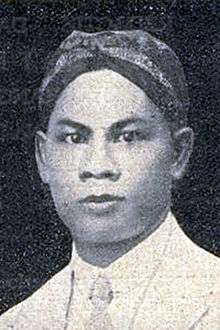Oto Iskandar di Nata
| Raden Oto Iskandar di Nata | |
|---|---|
 | |
| State Minister of Indonesia | |
|
In office 19 August 1945 – 14 November 1945 | |
| President | Sukarno |
| Personal details | |
| Born |
31 March 1897 Bojongsoang, Bandung, Dutch East Indies |
| Disappeared |
19 December 1945 (aged 48) Tangerang, West Java, Indonesia |
| Status |
Retrospectively declared dead in absentia 20 December 1945 (aged 48) |
Raden Oto Iskandar di Nata (Sundanese: ᮛ᮪ᮓ᮪. ᮇᮒ᮪ᮒᮧ ᮄᮞ᮪ᮊᮔ᮪ᮓᮁᮓᮤᮔᮒ; also spelled Raden Oto Iskandardinata, also nicknamed Otista; 31 March 1897–20 December 1945) was a fighter for Indonesia's liberation from Dutch rule, and an Indonesian State Minister. He is considered a National Hero of Indonesia.
Work
In his activities during the period before independence, Otto had served as Deputy Chairperson of the Bandung branch of Budi Utomo in the period 1921-1924 , as well as Deputy Chairperson Budi Utomo in Pekalongan branch in 1924. At that time, he became a member of Gemeenteraad ("City Council") Pekalongan represented Budi Utomo.[1]
Oto was also active in Sundanese cultural organizations called Paguyuban Pasundan . He became Secretary of the Executive Board in 1928 , and became chairman in the period 1929-1942 . The organization is engaged in education, socio-cultural, political, economic, youth and women's empowerment.[2]
Oto also became a member of the Volksraad ("People's Council", a kind of DPR) which was formed during the period of the Dutch East Indies for the period 1930-1941.[3]
During the Japanese occupation , Otto became the Leader of the Tjahaja newspaper (1942-1945). He later became a member of the BPUPKI and PPKI formed by the Japanese occupation government as institutions that helped prepare for Indonesia's independence.[3]
Disappearance
Based on the information given by witnesses, Otista's murder took place on the beach of Mauk in Tangerang, and his body was thrown into the sea. He was abducted by youths and beheaded on a beach in present-day Mauk District, Tangerang Regency in Banten (formerly under West Java provincial administration) by a group called "The Black Troop" (Indonesian: Laskar Hitam).[4] His body was claimed to have been dumped into Java Sea and was never found.
Aftermath
On 21 December 1952, his funeral in absentia was held. His body was replaced by sand and water taken from the beach, and interred in a cemetery in Lembang, West Bandung Regency. He was designated as National Hero of Indonesia in 1973, legally declaring him dead, as the title is posthumous.
Otista's image appears on the 2004–2016 series of the 20,000 Indonesian rupiah note.

See also
References
- ↑ Enam fakta Oto Iskandar di nata yang tersembunyi ayobandung.com Retrieved 2 October 2018
- ↑ "Generasi Muda Sunda Diminta Kenali Oto Iskandar Di Nata - Republika Online". Retrieved 2 October 2018.
- 1 2 "Menguak Rahasia Oto Iskandar Di Nata". 16 December 2017. Retrieved 2 October 2018.
- ↑ Post, The Jakarta. "Tomb of Tan Malaka, finally". The Jakarta Post. Retrieved 2018-09-23.